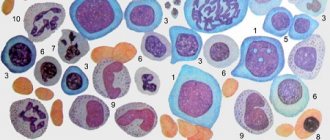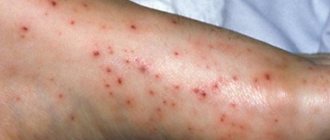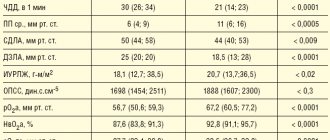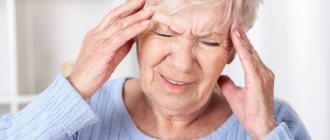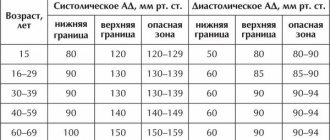Treatment of B12 deficiency anemia in the elderly: regimen and medications
Long-term use of vitamins is provided - initially daily, then in a reduced dosage.
The regimen for taking medications is determined individually by a specialist. The doctor prescribes a treatment regimen for an elderly person. If the patient is unable to take the necessary medications on time, control of the drug treatment regimen is undertaken by:
- in the case of home treatment - relatives or spouses;
- in the hospital - junior medical staff;
- in a boarding house or care home - nurses and caregivers.
Vitamins B12 are cyanocobalamin, hydroxocobalamin, methylcobalamin and cobamamide. In a healthy person, vitamin B12 is synthesized by microorganisms in the digestive tract. When the absorption of your own B12 is impaired, only the vitamin from food is absorbed. Therefore, in addition to drug therapy, you should adhere to a diet based on meat and animal by-products. Especially useful: beef liver, chicken liver and heart.
The drug B12 is sold in the form of tablets, solution for intramuscular injection and drops. The form of the drug, as well as the dosage regimen, is prescribed by the attending physician.
Treatment of iron deficiency anemia in the elderly
First of all, they act on the underlying disease. The drug course is supplemented with inexpensive iron-containing drugs. If there are problems with the intestines, they resort to droppers or injections. The medication is prescribed in a daily dosage of 300 mg, divided into two doses.
In the case of folate deficiency anemia, pharmacological products with folic acid are effective, the standard daily dosage of which is 5 mg. The prescribed drug is taken in short courses. The ability of the active substance to cause neurological disorders in epilepsy must be taken into account.
Causes of anemia in old age
According to statistics, more than 30% of older people experience symptoms of low hemoglobin. Among the main reasons for the development of this pathology it is worth noting:
- Anemia (anemia) caused by various chronic diseases. Often, infectious, autoimmune and oncological diseases are accompanied by low levels and concentrations of hemoglobin in the blood. This type of anemia is usually treated simultaneously with the main diagnosis.
- Iron deficiency. Insufficient iron to maintain normal functioning of the blood and tissues, including muscles and brain, is the most common cause of anemia. Most often observed with poor nutrition and large blood losses.
- Folic acid deficiency. Caused by insufficient consumption of foods fortified with folic acid. Its deficiency is compensated by taking certain medications.
- Lack of vitamin B12. Symptoms of vitamin B12 deficiency: anemia, numbness in the limbs, problems with coordination and memory. You can replenish your vitamin supply from animal products: beef, lamb, egg yolk, cod, mackerel, nuts, beef liver, seafood (mussels, shrimp).
Low hemoglobin in the blood often causes prolonged wound healing. In addition, low iron levels may indicate the development of neoplasms.
Increased hemoglobin
High levels of hemoglobin are observed in people who live in the mountains, actively engage in sports or heavy physical labor. Increased hemoglobin in these cases compensates for the lack of oxygen in the blood.
If an older person does not belong to one of these groups, high hemoglobin may indicate the following problems:
• Heart failure and other heart diseases • Congenital heart disease, cardiac dysfunction • Kidney or liver cancer • Emphysema, pulmonary diseases, obstructive process • Excessive use of cigarettes or living in a polluted urban area • Frequent and uncontrolled use of diuretics
Increased hemoglobin does not manifest itself in any way externally; it can only be determined by a blood test.
To reduce high hemoglobin levels in older people, you need to work with your diet. If high levels are detected, they must be brought back to normal with the help of special nutrition.
The basis of the therapeutic diet is a reduction in animal proteins. Products that are recommended to be included in the diet of people with low hemoglobin should be excluded for people with high hemoglobin. A person with high hemoglobin is prohibited from eating red meat and meat products, red vegetables and fruits.
The diet should contain vegetable proteins (dairy, legumes), folic acid (fresh vegetables, herbs), polyunsaturated fatty acids (seafood, sea fish).
Elderly people need to regularly monitor the hemoglobin content in their blood. Violation of its norms is a signal that something is wrong with your health. By starting treatment on time, you can improve your condition and prevent complications.
Symptoms of anemia in old age
Anemia is a dangerous condition in which the number of red blood cells in the blood decreases, and the transport of oxygen necessary to ensure the vital activity of cells and tissues is disrupted. With anemia, any pathology takes much longer to treat - this is due to a decrease in physical activity and a deterioration in the functioning of the cardiovascular system. However, some people do not consider anemia a serious condition and ignore its symptoms, thereby increasing the risk of serious complications when treated for other conditions.
The symptoms of anemia are vague, which is why they are often confused with other diseases characteristic of older people. Most often, anemia is manifested by such symptoms as:
- Dizziness, loss of balance.
- Frequent headaches and mood swings.
- Muscle weakness.
- Increased irritability.
- Poorly healing wounds (“jams” in the lip area).
- Change in taste sensations.
- “Floaters” or “veil” before the eyes.
- Pale and dry skin.
- Brittle nails.
- Chronic fatigue.
In addition, people suffering from anemia are often worried about the stomach, intestines, and diseases of the cardiovascular system. They often complain of rapid heartbeat and tinnitus.
If at the early stage of development of the pathology these symptoms do not cause concern, then over time they become permanent and cause discomfort. To avoid serious consequences, it is important to consult a doctor promptly. The specialist will prescribe a number of diagnostic measures and complex therapy.
Diagnostics
The main method for diagnosing anemia is a general blood test, which reveals a decrease in the level of hemoglobin in the blood in women less than 120 g/l and in men less than 130 g/l. In old age, this limit is slightly lower and the normal hemoglobin level is 110 g/l.
If the indicator is reduced to 70-90 g/l, then this indicates moderate anemia. In severe forms of pathology, hemoglobin levels are lower than 70 g/l. In this case, urgent hospitalization and treatment in a hospital are required.
Additional diagnostic methods include:
- Blood chemistry.
- Determination of ferritin and serum iron levels.
- Total iron binding capacity of serum.
- Determination of the number of red blood cells, level and concentration of hemoglobin.
- Transferrin receptor study.
In addition, the doctor collects anamnesis and conducts a visual examination of the patient. If a change in the size of the spleen (during palpation) and the color of the skin is noticed, an additional examination is prescribed.
Why is hemoglobin low in older people?
Anemia , or a decrease in hemoglobin less than 110 g/l, is found in almost half of older people over sixty. Previously, it was believed that this was somehow related to age, but this hypothesis was abandoned over time. Doctors have found that the blood in the body of an elderly person continues to work as before, without reducing its functionality. Therefore, the problem with hemoglobin has nothing to do with age; the reason must be sought elsewhere.
Why does hemoglobin drop in older people? By the way, men suffer from anemia more often than women. But the lack of iron-containing protein in the blood inside red blood cells is not associated with gender, but with the presence of certain chronic diseases. Low hemoglobin levels in the blood can be caused by persistent infections and tumors, as well as various diseases of the heart, endocrine or autoimmune systems of the body. Moreover, a certain kind of vicious circle is possible here: chronic diseases lead to a decrease in hemoglobin levels in older people, and this, in turn, provokes an increase in the severity of these ailments.
Insufficient intake of iron into the body or its regular loss can cause the development of iron deficiency anemia. The culprits of such an imbalance may be an improper diet or illnesses of older people, which are accompanied by constant bleeding. These include gastric and duodenal ulcers, ulcerative colitis, intestinal diverticulitis, Crohn's disease, and various tumors.
Another reason for insufficient hemoglobin levels in older people may be a lack of vitamin B12 and folic acid .
If a person suffers from anemia, this can be determined by the following symptoms:
- the skin becomes pale;
- pulse and breathing increase;
- a person gets tired quickly;
- the head begins to hurt frequently;
- dizziness appears;
- possible tinnitus;
- spots appear in the eyes;
- muscle weakness develops;
- it becomes difficult to concentrate on anything;
- the person becomes irritable;
- lethargy appears;
- the temperature rises slightly.
In some cases, there is already a lack of iron in the body of older people, but it is not yet possible to understand this from analysis. In such a situation, you should pay attention to the symptoms preceding anemia:
- a person’s skin becomes dry;
- he is drawn to inedible things;
- painful cracks appear in the corner of the mouth;
- nails become pale and brittle, longitudinal grooves appear on them;
- hair also becomes brittle and brittle, and there is a tendency towards baldness;
- there is pain, burning, flattening of the tongue.
The lower the hemoglobin level in an elderly person, the more severe these symptoms are. If there is very little iron-containing protein in the blood, then a person is able to feel such weakness and dizziness that his consciousness may become confused, and fainting is likely. The mucous membranes and skin become pale.
- Recommended articles to read:
- Social services for older people
- Diseases of old age
- Valuable tips on how to choose a boarding house
In cases where hemoglobin in older people has dropped slightly, this may not be noticed. Usually, accompanying symptoms in the form of lethargy and dizziness are attributed to some other chronic illness. But the disease cannot be neglected, so at the slightest suspicion of anemia you need to do a blood test . Thanks to him, the doctor can easily find out the degree of anemia and its type, which is determined by the characteristics of red blood cells. When diagnosing, attention is also paid to concomitant chronic diseases that the elderly person suffers from. Then treatment is prescribed to eliminate the very cause of the decrease in hemoglobin.
If the diagnosis is made on time and the necessary therapy is started immediately, then anemia can be overcome without any problems. An elderly person's hemoglobin will rise quite quickly, and with it new strength will come.
But if the disease is neglected, it threatens the development of chronic iron deficiency, the symptoms of which are lethargy and dizziness, confusion and fainting. The skin of an elderly person will begin to peel and crack, becoming dry and pale. This set of symptoms is called typical anemic syndrome.
Anemia has several degrees, but the third is the most severe. In older people, whose hemoglobin has dropped very significantly, tremors and muscle atonia develop, blood pressure surges begin, bradycardia, tachycardia and frequent fainting are observed.
Also, a significant decrease in hemoglobin levels threatens an elderly person with oxygen starvation of the brain, which can cause the development of Alzheimer's disease.
The factors that cause hemoglobin to drop in older people are essentially the same as at any other age. But the fact is that the disease affects this group of patients much more strongly, and ordinary anemia quickly turns into chronic anemia. If a person is over 65 years old, then the likelihood of such a pathology is even greater.
And that's not all. In older women with low hemoglobin, the risk of developing tumors of the reproductive system increases. For older men, a lack of iron-containing protein can cause early dementia.
As already mentioned, older men, especially those over 60, suffer from anemia much more often, so they are recommended to have a blood test at least once every three months - even if there are no signs of the disease.
Read the material on the topic: Medicines for the elderly: 13 tips for taking medications
Features of anemia treatment
Before prescribing treatment, the specialist takes into account laboratory data, as well as the presence of chronic diseases and the age of the elderly person. At an early stage of pathology, when hemoglobin levels are not critical, its deficiency is corrected with a special diet.
When it comes to moderate anemia, medications are prescribed that promote the formation of red blood cells and hemoglobin in blood cells. The most commonly prescribed iron preparations are Ferrum, Actiferrin and Maltofer.
In severe cases of anemia (critical hemoglobin levels below 70 g/l), a red blood cell transfusion is prescribed. To avoid adverse reactions, this procedure is carried out under the supervision of a doctor.
All medications are taken strictly according to the regimen prescribed by the attending physician. If side effects occur (stomach pain, nausea, constipation, diarrhea, dizziness), treatment is adjusted or other drugs are prescribed (intravenous or intramuscular injections).
Treatment of anemia is quite long - from 3 to 6 months and, in addition to taking medicinal iron-containing drugs, includes a special diet, dietary supplements and vitamin-mineral complexes.
Diet for anemia
A special diet is one of the effective ways to increase the level of hemoglobin in the blood. In addition, it is also an excellent prevention of the development of anemia. At the initial stage of anemia, it is recommended to eat foods high in protein, since it is protein that promotes good hemoglobin synthesis.
You should also include in your daily diet foods high in iron (beef liver and kidneys, pomegranate, apricots, green apples).
List of products recommended by nutritionists for anemia:
- Vegetables, berries, fruits (citrus fruits, tomatoes, sweet peppers, rowan, sea buckthorn).
- Animal proteins (chicken yolk, meat (veal, beef), seafood, seaweed).
- Nuts (pine, hazelnuts, peanuts, cashews).
- Sunflower seeds, sesame, wheat bran,
- Chocolate (bitter).
- Buckwheat, lentils (grain), soybeans (grain), peas, barley (grain), oat bran, beans (grain).
- Porcini mushrooms (dried).
People suffering from anemia need to exclude foods high in “fast carbohydrates” from their diet:
- Baked goods made from wheat flour.
- Dates.
- Milk chocolate.
- Watermelon, grapes.
- Sugar, honey
- Semolina, potatoes, pasta (with the exception of durum wheat pasta).
Nutritionists recommend that people on a diet eat meals at approximately the same time each day and avoid feeling hungry.
For anemia, freshly squeezed juices from pomegranate (diluted), carrots and beets are useful. Their daily consumption will enrich the diet and increase the level of hemoglobin in the blood. In addition, a large number of microelements important for the body are contained in the infusion of fresh and dry rose hips.
Important! When consuming dairy products, you should be aware of their incompatibility with medications containing iron. Also, during the treatment of anemia, you should avoid drinking strong black tea, as it interferes with the absorption of iron.
ethnoscience
Proven folk remedies are often used to treat anemia. The most effective:
- Infusion of rowan fruits. Steam two tablespoons (tablespoons) of rowan with 200 ml of boiling water, leave for half an hour, strain, drink 70 ml three times a day before meals. The course is two weeks.
- Infusion of nettle leaves. 1 tbsp. l. raw materials pour 300 ml of boiling water, take 100 ml 3 times a day before meals. The course is two weeks.
- Vitamin mixture. Mix dried fruits (dried apricots, prunes, raisins) in proportions 1:1, steam 200 ml of boiled water overnight, strain, mince. Use 1 tbsp. l. three times a day before meals. Course – 7-10 days.
Compliance with dietary nutrition in combination with drug therapy allows you to achieve high results and normalize the level of hemoglobin in the blood, the main thing is to follow the instructions of your doctor.
Additional recommendations
It is recommended to carefully monitor your diet. Men and women with anemic symptoms should absolutely not fast. At the same time, you will need to avoid overeating. It is advisable to eat without long breaks, making sure that the portions are moderate but satisfying.
It is recommended to enrich the table with vegetables and herbs, not too fatty meat and fish, and dairy products. Doctors warn that in adulthood you should not engage in various experiments. At this stage of life, it is undesirable to practice vegetarianism, as well as other unsafe “innovations”.
Porridge is a must on the menu. Buckwheat has the greatest benefits. It is allowed to periodically eat beets, cabbage, and chicken eggs. Legumes are not prohibited, but as a person ages, they become less digestible.
A common problem of old age is poor dental health. Chopping raw vegetables using a grater or blender helps make eating easier.
Old age requires careful treatment of your own body. During this period of life, detailed medical examinations are required and the required tests are taken. At the slightest deterioration, you must immediately seek qualified help. There is no need to leave old diseases unattended. It is advisable for persons with such diagnoses to be under the supervision of specialists.
Anemia always requires early detection and the closest attention. It is most difficult in people over 60-65 years of age. During this period, it will not be superfluous to have another medical examination, which will help identify the problem and clarify the circumstances of its occurrence.
If anemic signs are detected, it is important to follow all the doctor’s instructions to successfully get rid of the pathology and prevent an unwanted relapse.
Prevention of anemia
To reduce the risk of developing anemia, you need to follow the following recommendations from specialists:
- Eat right, including foods high in iron and animal protein in your daily diet.
- Eat at least 0.5 kg of fruits and vegetables every day.
- Once a year, every six months, take vitamin-mineral complexes and preparations with B12 and folic acid.
- Eliminate helminthic infestation.
- Avoid direct contact with toxic substances and chemicals.
- Take daily walks.
- Lead an active lifestyle.
- Maintain a sleep schedule (at least 7 hours).
Preventive measures in old age do not always give good results. To prevent the development of anemia, it is recommended to undergo a comprehensive examination once a year, and if any pathologies are detected, follow the recommendations of a specialist.
Normal blood protein level
Blood counts must comply with generally accepted standards. The hemoglobin level may vary throughout life. So, a liter of a man’s blood contains 130-160 g of hemoglobin, for women this figure is 120-155 g. And when the norm turns out to be lower or higher, this affects the well-being of both young and old people. And depending on the results of the analysis, this display should be lowered or increased.
The reasons why hemoglobin drops can be very different. This may happen if:
- the person has lost a large amount of blood;
- his diet is monotonous and incomplete;
- he abuses alcohol;
- suffers from an illness such as chronic enteritis or various infectious diseases;
- underwent long-term treatment with droppers, etc.
